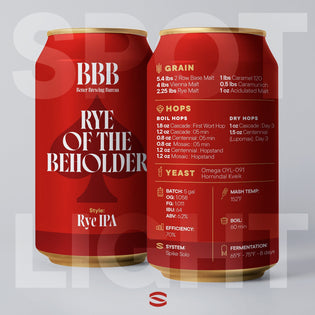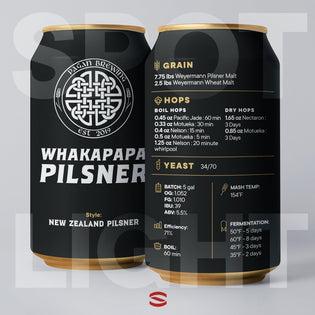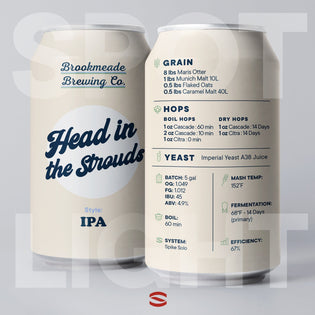
The Brewer: pixelHop Beer Company
We’re heading out west (and climbing to a higher elevation) to hang with Adam from pixelHop Beer Company in Denver, Colorado. “I brewed my first batch around 2005,” Adam tells Spike. “My college roommate discovered it was legal for us to brew beer even though we couldn’t buy it,” he chuckles. "I made my first all-grain recipe (peanut butter brown ale) in 2018 and won gold medals in consecutive competitions. That sparked my competitive nature.
In 2019, I received an undergrad certificate in Applied Craft Brewing from Regis University and did an internship with Little Machine in Denver. I moved to Spike equipment and haven’t looked back.
![]()
A three-vessel system gives the feeling of brewing commercially. The Spike Conicals offer great features at a competitive price. There’s a lot of possibility for experimentation due to the removable lid and number of ports.” The name pixelHop was derived from the digital and artistic side of brewing. “Pixels were a natural fit,” Adam says. “With Denver being 5.280 feet high, I also wanted a name which could be abbreviated as “pH” as a nod to the oft-desired mash pH of 5.2.”
![]()
When asked what his one piece of advice would be for those looking to get into a new hobby, Adam simply replied, “If you’re over 30, it’s time to commit your personality to brewing beer or grilling meat. Make the right choice…”
The Beer: Mexican Lager
“I feel a Mexican Lager is a good example of a style which benefits from Spike's conical capabilities, since it can be fermented under pressure to reduce unwanted fermentation characteristics (such as ester production) so you come away with a nice, clean flavor profile. This beer was a consistent competition performer for me, earning 2 gold medals, 1 silver, and 1 bronze. It also achieved my highest consensus competition score for the year of 46/50.”

“This was a recipe I made at the last minute before Cinco de Mayo in 2020. I chose the yeast I did because it was supposed to perform well under pressure and I wanted to have the beer finished more quickly."
The Recipe: 20 West

INGREDIENTS
GRAIN
- 3 lbs Pale 2-Row
- 1.75 lbs Pilsner
- 1.5 lbs Flaked Corn (20L)
- 1lbs Vienna
- 0.5 lbs Munich II (20L)
- 0.3 lbs Rice Hulls
HOPS
- Boil HopsL 0.75 oz Hallertau Magnum (12% AA) -: 60 min
- Boil hops: 0.5 oz Hallertau Mittelfrueh (4% AA) -: 10 min
YEAST
- White Labs WLP925 High Pressure Lager Yeast

INSTRUCTIONS
BATCH SIZE: 5 gal
OG: 1.047
FG: 1.01
IBU: 21
ABV: 4.9%
EFFICIENCY: 80%
MASH TEMP: 152 ºF
BOIL: 90 min
FERMENTATION: 62ºF - 7 days at 14psi
65ºF - 3 to 5 days
60ºF - 1 day
40ºF - 4 weeks
SYSTEM: Spike Trio
![]()
Pro Tip
After a diacetyl rest, I recommend lowering fermentation temp to 60 degrees F for one day, then dropping by 2 degrees each day until it's at 40 degrees. The beer can lager at 40 or below for as long as patience allows. Slowly lowering fermentation temp also helps prevent ester release.
Cheers,
Adam Thompson – pixelHop Beer Co.
Spike Summarizes: All Things Mexican Lager
What is the history of Mexican Lager?
Believe it or not, Mexican Lager has its roots in the mid-19th century, influenced heavily by German immigration to Mexico. German brewers brought their lager-brewing techniques with them, leading to the birth of this now widely popular beer style.
How does Mexican Lager compare to other types of beer?
Light and Refreshing
Mexican Lagers are typically lighter than many other beer styles, offering a crisp, refreshing taste. They're often characterized by a clean malt flavor, minimal hop bitterness, and a smooth finish, making them the perfect accompaniment to a hot summer day.
What is the ideal food pairing for Mexican Lager?
Perfect for Spicy Food
Mexican Lagers are incredibly food-friendly, but they shine brightest when paired with spicy foods. The beer's lightness and carbonation help to tame the heat while cleansing the palate. Think tacos, enchiladas, or a spicy barbecue - this beer style is a match made in heaven for these dishes.
Is Mexican Lager a Summer beer?
A Beer for All Seasons
While Mexican Lagers are perfect for sipping on a hot summer's day thanks to their light, refreshing qualities, don't let that limit you! This versatile beer style can be enjoyed all year round, whether you're basking in the summer sun or seeking a lighter beer option during the cooler months.
What are the key ingredients in Mexican Lager?
Simple and Effective
The primary ingredients in a Mexican Lager are water, barley malt, hops, and yeast. Some versions also incorporate corn or rice adjuncts to lighten the body and flavor. The result is a beer that's light, refreshing, and easy to drink.
What's the typical ABV of Mexican Lager?
Lower ABV
Mexican Lagers typically have a lower alcohol content, usually around 4-5% ABV. This makes them a great choice if you're looking for a beer that's less potent, allowing you to enjoy a couple without feeling overly tipsy.
How is Mexican Lager beer brewed?
Traditional Lager Brewing
Mexican Lagers are brewed using traditional lager techniques, including bottom fermentation at colder temperatures. This brewing process results in a beer that's crisp, clean, and refreshing, with a smoothness that's hard to beat.
What's the best temperature to serve Mexican Lager beer?
Ice Cold
Mexican Lagers are best served ice cold, typically around 38-40°F (3-4°C). This enhances their refreshing qualities and makes them an excellent choice for hot weather drinking.
Why is Mexican Lager beer so carbonated?
Enhancing Refreshment
The high level of carbonation in Mexican Lager not only provides a satisfying mouthfeel but also enhances the beer's refreshing qualities. It also helps to lift the beer's light flavors, making each sip a delight.
Are all Mexican Lager beers the same?
Variety within the Style
While all Mexican Lagers share a base profile of being light, crisp, and refreshing, there's still a variety within the style. Some may have a more pronounced malt character, while others might have subtle hoppy notes or a slightly sweeter finish.
What are craft Mexican Lagers?
Craft Breweries Explore the Style
Though Mexican Lagers are often associated with big names like Corona or Modelo, the craft beer scene has been experimenting with this style as well. Many craft breweries have started to produce their own Mexican Lagers, often adding a unique twist. Some may experiment with different types of malt, or add in unique flavors like lime or even agave.
Are there different sub-styles of Mexican Lagers?
Sub-styles Abound
Yes, there are! Two common sub-styles you might come across are the Mexican Amber Lager and Mexican Dark Lager. The Amber Lager is a bit fuller-bodied with a more pronounced malt character, while the Dark Lager, often known as "Negra," has a deeper color and can exhibit chocolate or caramel notes.
How has the popularity of Mexican Lager evolved?
Growing Popularity
Mexican Lagers have seen a surge in popularity, particularly in the United States. The combination of their easy-drinking nature and versatility with a range of foods has helped to elevate their status. Plus, as craft breweries continue to explore and experiment with this style, we can only expect its popularity to continue to grow.
And that wraps up our journey into the world of Mexican Lagers! We hope you've learned a thing or two and perhaps even found a new beer style to love. Remember, the world of beer is full of rich history, diverse flavors, and endless possibilities to explore. So, keep your taste buds curious, and as always, enjoy responsibly. Salud!





